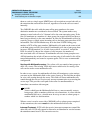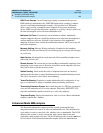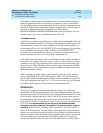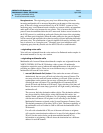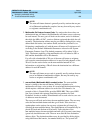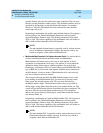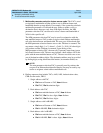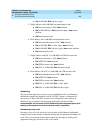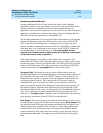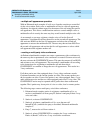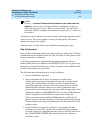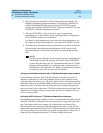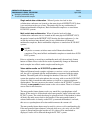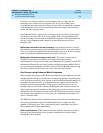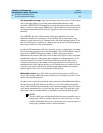
DEFINITY ECS Release 8.2
Administrator’s Guide
555-233-506
Issue 1
April 2000
Managing multimedia calling
270Enhanced Mode MM complex
9
Answering multimedia calls
Incoming multimedia calls will alert at the voice station of the Enhanced
multimedia complex in the same manner as voice calls with one addition. If the
alerting station has an administered mm-call button and the alerting call
appearance is the selected call appearance (i.e. the red led is lit, on the alerting call
appearance), then the mm-call button status lamp will go on indicating that the
call on the selected call appearance is a multimedia call.
The incoming multimedia call is answered in the normal manner by selecting the
alerting call appearance and going off-hook on the voice station. If the H.320
DVC system for the answering party is configured for auto-answer, no other
action is needed to complete the multimedia call. If the H.320 DVC system for the
answering party is not configured for auto-answer, the H.320 DVC system will
alert and must also be answered by the user.
It is recommended, but not
required, that Enhanced mode complexes place their desktop video system
into an auto-answer mode of operation.
If the originating party is providing a video signal, then a complete 2-way
multimedia call will exist. If the originating party is not providing a video signal,
the answering party will receive loopback video. The audio signal will exist at the
handset of the voice station. The audio signal may be moved to the H.320 DVC
system via activation of a
mm-pcaudio button on the voice station.
Hourglass Tone. The answering party may hear different things when the
incoming multimedia call is answered depending on the nature of the originator. If
the origination is directly from an H.320 DVC system or if the originator is an
Enhanced mode complex on a remote switch, an immediate audio path will not
exist between the two parties. This is because the H.320 protocol must be
established after the call is answered. It takes several seconds for the H.320
protocol to establish an audio path. During this interval the answering party will
hear special ringback. When the audio path exists the special ringback will be
removed and replaced with a short “incoming call tone” indicating that audio now
exists. The combination of special ringback followed by incoming call tone is
referred to as
“hourglass tone.” Hourglass tone is an indication to the answering
party that they should wait for the H.320 call to establish audio.
Early Answer. The answering party may administer their station in such a way as
to avoid hearing hourglass tone. If the station form has set the
Early Answer field
to
y, then the system will answer the incoming multimedia call on behalf of the
station and proceed to establish the H.320 protocol. After audio path has been
established, the call will then alert at the voice station of the Enhanced mode
complex destination. The station may then answer by going off-hook and will
have immediate audio path. No hourglass tone will be heard by the answering
party.



